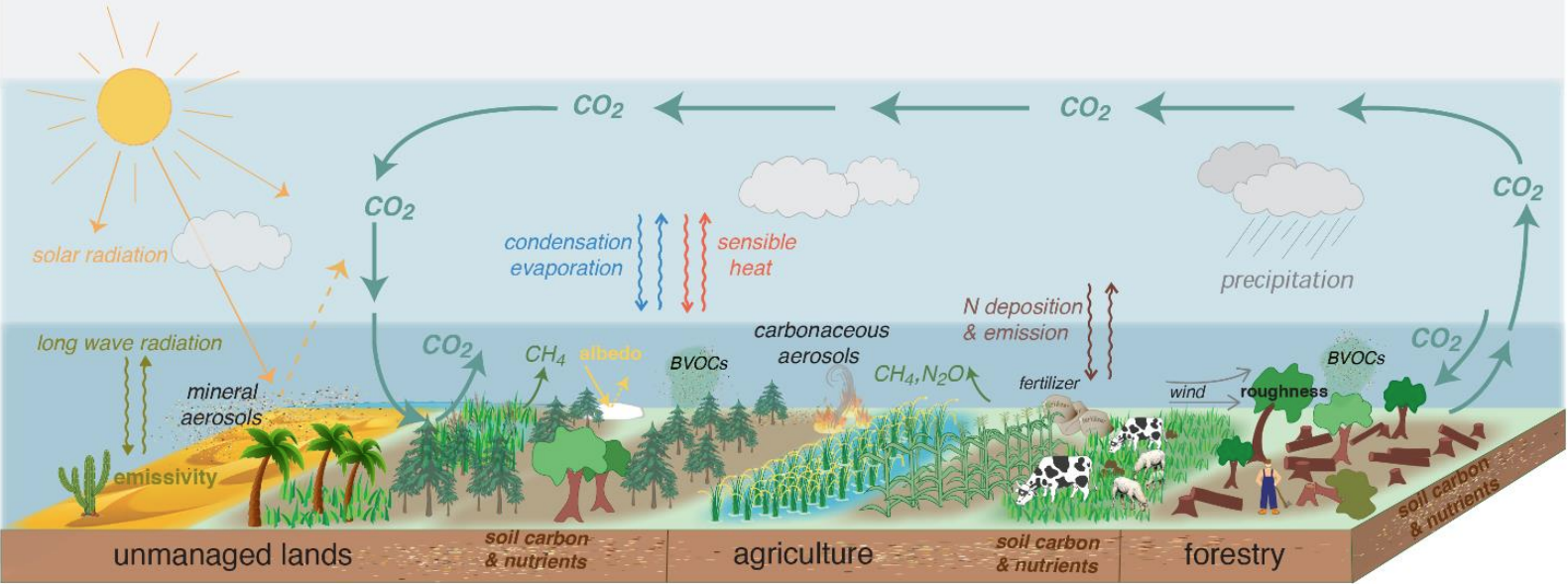A new report from the Intergovernmental Panel on Climate Change (IPCC) highlights the large global potential of locally implemented land-based solutions that can simultaneously mitigate climate change and ensure food security. It underlines, however, that land-based actions alone will not be sufficient to meet the 2°C Paris climate target.
In the News
In August 2019 the Intergovernmental Panel on Climate Change (IPCC) released its special report on Climate Change and Land, the second in a series of special thematic reports in the last year. The report summarizes the most up-to-date science on the linkages between climate change, desertification, land degradation, sustainable land management, food security and greenhouse gas fluxes. Central in the report is the acknowledgement that land is essential for human well-being, but under increasing pressure from land-use and climate change. The report also estimates agricultural, forestry and other land uses (AFOLU) sectors accounts for 23% of total human-driven emissions.
What’s different about this report?
The Climate Change and Land report marks the first IPCC report where the authorship is composed primarily of scientists from the Global South (53%) and as such the process undertaken in the creation of the report and its recommendations are reflective of a greater diversity in world views. The report also embraces a stronger focus on bottom-up and regional analysis of the drivers, trends and interactions between land-climate change than previously IPCC assessments focused at the global level. This regional focus has brought greater complementarity in results to the on-going work of the Inter-governmental Science-Policy Platform on Biodiversity and Ecosystem Services (IPBES) which takes a strong regional approach to biodiversity and ecosystem service assessments. As well, recommendations emerging from this Climate Change and Land report are more cautious in than previous IPCC assessments, cognizant of context-dependent nature of adaptation and mitigation actions, particularly in the case of bioenergy with carbon capture and storage (BECCS) technologies.
What can we learn from this report?
Land is essential for humans and is subject to an ongoing paradox. Namely, land-use, particularly through the global food system, is a major contributor to climate change, accounting for 23% of total anthropogenic emissions (Figure 1). At the same time, land systems are highly vulnerable to climate change (see box 1). In its focus on land-based food systems, the report notes that agriculture is still the main driver of deforestation leading to major CO2 emissions, however, subsequent land use to raise crops and livestock is leading to an important growth of manure, fertilizer, and soil nitrous oxide (N2O) and methane (CH4) emissions, much more potent greenhouse gases than CO2. At the same time, land ecosystems offer powerful means of climate change mitigation, because they can absorb and store large amounts of atmospheric carbon.
Due to the diversity of local ecosystems, land uses, agricultural systems and cultural practices globally, there is no single solution to addressing the land-climate change challenge. Rather the report identifies that many land-based strategies exist to mitigate climate change that do not lead to land competition and that can provide multiple benefits in the context of food security, prevention of degradation, reduced biodiversity loss and climate-change mitigation. Powerful land-based mitigation options exist, but they cannot substitute for a rapid societal transition to low-carbon system across all sectors of society. Delayed action in climate change mitigation will ultimately lead to increased pressures on land ecosystems.

The food system as an important solution space for climate action with potential for multiple co-benefits
The report states that 25-30% of total GHG emissions are attributable to the food system from agriculture and land use, storage, transport, packaging, processing, retail, and consumption. This suggest that better management and transformations in our food production systems can have profound influence on climate change impacts. Many land-based solutions are already being implemented in various parts of the world that need to be scaled. These include both demand and supply-side actions each of which are described in more detail below.
The report highlights that demand-side actions, that reduce the amount of land needed to produce healthy diets, are equally important to supply-side improvements in land productivity. Shifts towards plant-based diets and away from emissions-intensive meat production (0.7–8.0 GtCO2-eq /yr) and reduced food and agricultural waste (0.8–4.5 GtCO2-eq/yr) are highlighted as key actions pathways to mitigate climate change alongside reductions in deforestation and forest degradation (0.4–5.8 GtCO2-eq/yr). Such changes would reduce emissions and decrease the demand for land, while providing co-benefits in terms of human health, biodiversity and improved water quality.
However, supply-side actions are still central to addressing the land-climate challenge and include sustainable food production, improved and sustainable forest management, soil organic carbon management, ecosystem conservation and land restoration, reduced deforestation and degradation. Better management of soils can offset 5-10% of current global anthropogenic GHG emissions while also improving agricultural yields, reducing irrigation needs, and reducing sedimentation of waterways. Better timing and application of fertilizers to crop will be important to reduce N2O emissions without compromising yields, delivering co-benefits in terms of reduced water pollution and eutrophication that undermine food security and well-being. In some places, such as sub-Saharan Africa, fertilizer use will still needs to increase in order to avoid land degradation and to improve food security through increased crop yields (Zhang et al. 2015).
The impetus to act is strong as agriculture, and by extension food security, is extremely vulnerable to the impacts of climate change – particularly extreme events. Climate change is already impacting food security through increasing temperatures, changing precipitation patterns, and raising the intensity and frequency of some extreme events. Although warmer temperatures are improving crop yields at high latitudes, they are decreasing them towards the tropics. Higher CO2 is also projected to lower the nutritional quality (protein and mineral content) of the crops such as rice, with implications human nutrition up to 600 million people by mid-century (Zhu et al. 2018). Pastoral systems, practiced in nearly 75% of countries, are particularly vulnerable to warming and precipitation shifts as they primarily take place on fragile dryland systems. Based on indigenous and local knowledge, climate change is affecting food security in drylands, particularly those in Africa, and high mountain regions of Asia and South.
Sustainability Challenges and Ways Forward
Many adaptation and mitigation actions are well-known and in use across parts of the world, the challenge is to deploy them rapidly at scale while ensuring they remain appropriate to local socio-ecological contexts. The land and food sectors face particular challenges of institutional fragmentation and often suffer from a lack of engagement between stakeholders at different scales and narrowly focused policy objectives. Policies that enable and incentivise sustainable land management and reduce land degradation include improved access to markets for inputs, outputs and financial services, tenure reform, tax incentives, reforming subsidies and payment of ecosystem services. However, economic, political, institutional, legal and socio-cultural barriers, including lack of access to resources and knowledge, currently restrict their uptake.
Coordinated action across a range of actors is needed to enable conditions for uptake including engagement of businesses, producers, consumers, land managers and policymakers in partnership with indigenous peoples and local communities. Empowering women will be critical to create synergies and co-benefits to household food security and sustainable land management as women are central to food production but disproportionate vulnerability to climate change impacts. In addition, new research and technologies are needed to develop crop varieties and land management systems that are adapted to future climate regimes. As biomes shift, so too will the crops, species and management systems that accompany them. Farmers and landowners will need to access new knowledge and tools to transition their lands and make transformational changes to sustainability and must be supported through education, training and capacity building with a strong focus on farmer networks and rural advisory services.
How climate change affects land degradation
The report highlights the fact that climate change exacerbates many ongoing land degradation processes of managed ecosystems (i.e., managed forests, croplands and pastures), but also introduces novel degradation pathways in natural and seminatural ecosystems which can impact human well-being. Anthropogenic warming has shifted climate zones, expanding dry climates and decreasing polar climates. Ecosystems in these regions will become increasingly exposed to temperature and rainfall extremes beyond historic climate regimes which can alter their structure, composition and functioning. In particular, anthropogenic warming in high latitudes is leading to permafrost thawing, increased fire and pest outbreaks and coastal erosion from sea-level rise and changing storm paths. Similarly, increased fire in some tropical and temperate regions during normal to wetter than average years is being seen due to warmer temperatures that increase vegetation flammability. Many of these climate-driven forms of land degradation, indirectly caused by human activity, have not been seen before and can have a multitude of ecosystem and socioeconomic knock-on effects that impact human well-being.
Produced in collaboration with
Dr. Esteban Jobbágy, Grupo de Estudios Ambientales, IMASL-CONICET and Universidad Nacional de San Luis, San Luis, Argentina
Prof. Karlheinz Erb, Institute of Social Ecology (SEC) Department of Economics and Social Sciences (WiSo) University of Natural Resources and Life Sciences, Vienna, Austria
References
IPCC Special Report on Climate Change, Desertification, Land Degradation, Sustainable Land Management, Food Security, and Greenhouse gas fluxes in Terrestrial Ecosystems [Draft version] 2019. Available at: https://www.ipcc.ch/report/srccl/
Zhang, X., Davidson, E.A., Mauzerall, D.L., Searchinger, T.D., Dumas, P. and Shen, Y., 2015. Managing nitrogen for sustainable development. Nature, 528(7580), p.51.
Zhu, C., Kobayashi, K., Loladze, I., Zhu, J., Jiang, Q., Xu, X., Liu, G., Seneweera, S., Ebi, K.L., Drewnowski, A. and Fukagawa, N.K., 2018. Carbon dioxide (CO2) levels this century will alter the protein, micronutrients, and vitamin content of rice grains with potential health consequences for the poorest rice-dependent countries. Science advances, 4(5), p.eaaq1012.

